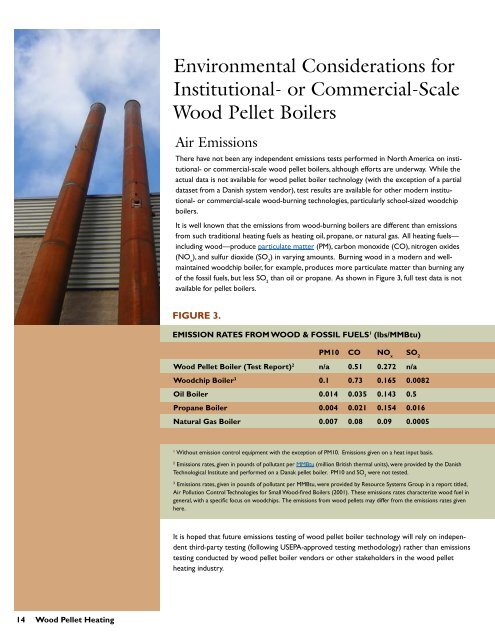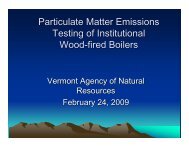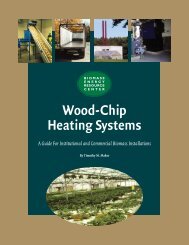Wood Pellet Heating - Biomass Energy Resource Center
Wood Pellet Heating - Biomass Energy Resource Center
Wood Pellet Heating - Biomass Energy Resource Center
Create successful ePaper yourself
Turn your PDF publications into a flip-book with our unique Google optimized e-Paper software.
Environmental Considerations for<br />
Institutional- or Commercial-Scale<br />
<strong>Wood</strong> <strong>Pellet</strong> Boilers<br />
Air Emissions<br />
There have not been any independent emissions tests performed in North America on institutional-<br />
or commercial-scale wood pellet boilers, although efforts are underway. While the<br />
actual data is not available for wood pellet boiler technology (with the exception of a partial<br />
dataset from a Danish system vendor), test results are available for other modern institutional-<br />
or commercial-scale wood-burning technologies, particularly school-sized woodchip<br />
boilers.<br />
It is well known that the emissions from wood-burning boilers are different than emissions<br />
from such traditional heating fuels as heating oil, propane, or natural gas. All heating fuels—<br />
including wood—produce particulate matter (PM), carbon monoxide (CO), nitrogen oxides<br />
(NO x<br />
), and sulfur dioxide (SO 2<br />
) in varying amounts. Burning wood in a modern and wellmaintained<br />
woodchip boiler, for example, produces more particulate matter than burning any<br />
of the fossil fuels, but less SO 2<br />
than oil or propane. As shown in Figure 3, full test data is not<br />
available for pellet boilers.<br />
Figure 3.<br />
EMISSION RATES FROM WOOD & FOSSIL FUELS 1 (lbs/MMBtu)<br />
PM10 CO NO x<br />
SO 2<br />
<strong>Wood</strong> <strong>Pellet</strong> Boiler (Test Report) 2 n/a 0.51 0.272 n/a<br />
<strong>Wood</strong>chip Boiler 3 0.1 0.73 0.165 0.0082<br />
Oil Boiler 0.014 0.035 0.143 0.5<br />
Propane Boiler 0.004 0.021 0.154 0.016<br />
Natural Gas Boiler 0.007 0.08 0.09 0.0005<br />
1<br />
Without emission control equipment with the exception of PM10. Emissions given on a heat input basis.<br />
2<br />
Emissions rates, given in pounds of pollutant per MMBtu (million British thermal units), were provided by the Danish<br />
Technological Institute and performed on a Danak pellet boiler. PM10 and SO 2<br />
were not tested.<br />
3<br />
Emissions rates, given in pounds of pollutant per MMBtu, were provided by <strong>Resource</strong> Systems Group in a report titled,<br />
Air Pollution Control Technologies for Small <strong>Wood</strong>-fired Boilers (2001). These emissions rates characterize wood fuel in<br />
general, with a specific focus on woodchips. The emissions from wood pellets may differ from the emissions rates given<br />
here.<br />
It is hoped that future emissions testing of wood pellet boiler technology will rely on independent<br />
third-party testing (following USEPA-approved testing methodology) rather than emissions<br />
testing conducted by wood pellet boiler vendors or other stakeholders in the wood pellet<br />
heating industry.<br />
14 <strong>Wood</strong> <strong>Pellet</strong> <strong>Heating</strong>





